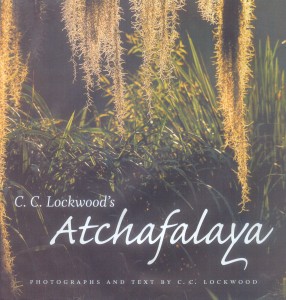BOOK REVIEW by Willard Manus
Anyone thinking of visiting Louisiana this winter would do well to pick up a copy of ATCHAFALAYA. With photographs and text by C.C. Lockwood, the picture book published by LSU Press captures the sumptuous beauty of the Atchafalaya Basin in the south-central part of the state, better known as the bayous.
Lockwood,
who lives in Baton Rouge, discovered the bayous in 1973, when he was a
struggling young photographer on assignment from Time-Life. First driving
around the levees in an old station wagon with a sleeping bag in back,
then taking to the waterways in a canoe (and later, a houseboat), he eventually
investigated just about every part of the 1.4 million-acre wilderness,
"meeting every old-time swamper that made the basin his full-time
home."

The life and beauty of the bayous touched Lockwood's soul and motivated
him to not only report on the region but fight for its survival. At one
time, he comments, "there was a Corps of Engineers plan to deepen
the channel of the Atchafalayan River in the interest of flood control.
But in fact the plan would have only complicated flooding problems. Making
the river channel two times bigger would have completely drained the swamp
in all but major flood years and tempted landowners to farm and build
within the flood-created levees around the swamp. Once the Basin was inhabited
by a few, it would be unavailable for flood control to protect the surrounding
area. It would be the ruin of a vital wetland."
Arming himself with a 16-mm movie camera, and with the help of Marty Stouffer, Lockwood shot a documentary film which was aimed at raising public consciousness. This was followed by a National Geographic article and a book which helped even more to preserve the wilderness he loved so much.
Now, twenty-five years later, Lockwood has produced a book in which he looks at the great swamp "with a mind and eyes that are older and maybe wiser. Exploring was what I liked most in my early days in the Basin. I liked to start down a bayou, and when it forked, I would take the right. Then again and again always taking the right until I reached a deadend. Then I would backtrack, following every fork I had passed in the other direction until I had seen the entire area. When I visit the Basin today, I'm not so much exploring, as I have now been to most places; yet every journey may be one of discovery, as the Atchafalaya can change from day to day. You can see not only the subtle changes of the seasons but also those brought by the rise and fall of the water from mormning to afternoon. So, in a sense, the exploring continues, as every day is differenmt. Each day I spend in the Atchafalay renews my spirit."
Lockwood's book contains dozens of his remarkable color photos which bring to life just about every aspect of the Basin--its lakes, rivers and foggy dawns, houseboats and lighthouses, oldtime oil rigs, alligator hunters, crawfish fishermen, wildlife, birdlife, dense forests, flowers and fauna.
All of that largely undeveloped splendor is captured in the book, but Lockwood isn't hopeful that the Basin will keep its virginity. "Its large expanse is habitat for creatures large and small, its woods and waters a recreational haven for all," he explains. "Yet we cannot rest, we cannot blink, for as long as man lives nearby, no part of the environment is truly safe. What we save today can always be destroyed by greed tomorrow. The Basin is Louisiana's greatest asset; it's worth the trouble to keep watching over it."
